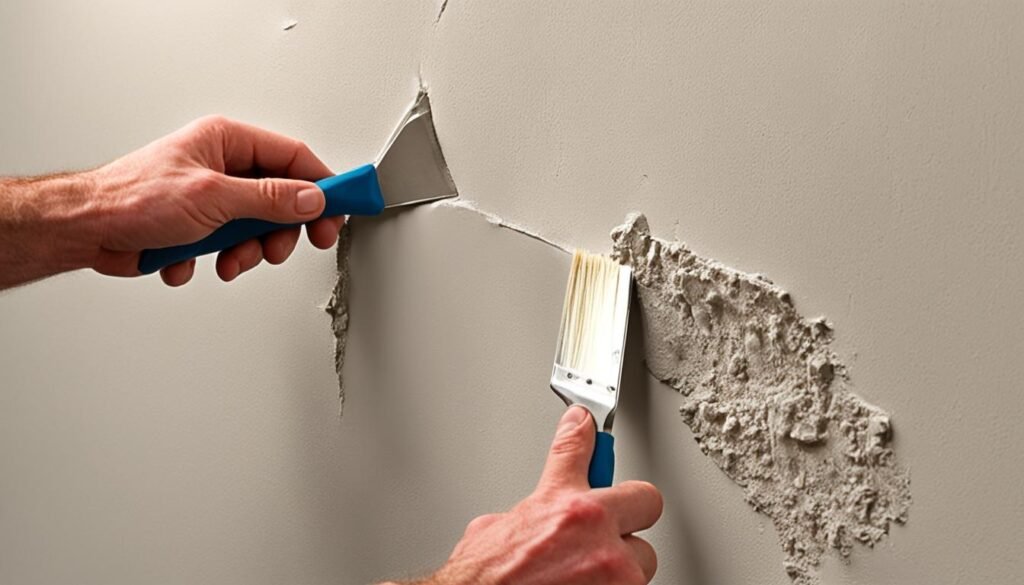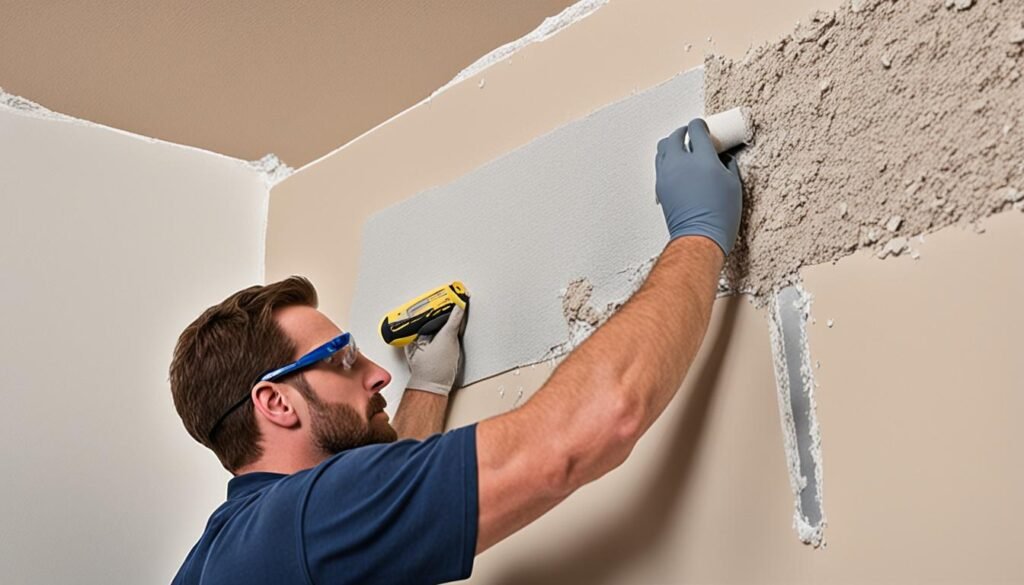Learning to fix holes in plaster walls is key for homeowners and DIY fans. Damage can come from furniture mishaps or just everyday wear. Luckily, with the right tools and skills, you can make your walls look new again without spending a lot. You might spend $10 to $15 and about 1 to 2 hours on this project, not counting drying time. This guide will show you how to save money and give you the confidence to fix plaster walls on your own.
Key Takeaways
- Understanding plaster walls is crucial in identifying the right repair methods.
- Common causes of holes include impact damage and wear over time.
- Proper tools are essential for effective plaster wall repair.
- Each repair step, from cleaning to smoothing, enhances the final result.
- Small holes require special techniques for a seamless finish.
- Identifying cracks helps determine the best repair methods.
- DIY repairs save money and enhance your home maintenance skills.
Understanding Plaster Walls
Getting to know plaster walls means learning about their build and what makes them special. They stand out from other walls because of their unique structure. Typically, plaster walls have many layers, put over wooden lath frames.
This method makes the walls strong and long-lasting. Plaster doesn’t just add strength; it also gives the walls a special look.
Plaster walls are great at controlling humidity, which makes the air inside healthier. They also help keep sounds from traveling, making rooms quieter. Knowing these benefits is key when fixing plaster walls. You can keep the wall’s strength and fix any damage well.
Common Causes of Holes in Plaster Walls
Knowing why holes appear in plaster walls is key for keeping your home in good shape. Many things can cause damage, and spotting these early helps you act fast.
One big reason is physical damage. Moving furniture or slamming doors can make holes. Also, not doing electrical work carefully can leave marks on the walls.
As houses settle, they can develop cracks and holes. This happens when materials move over time, putting stress on the plaster. Catching these problems early can help prevent bigger issues later.
Understanding what causes holes in plaster walls is vital. It helps you fix cracks before they get worse. This way, you can keep your walls looking great.
| Cause | Description | Prevention Tips |
|---|---|---|
| Physical Impacts | Damages caused by furniture, doors, or pets. | Use door stoppers and rearrange furniture strategically. |
| Electrical Work | Improper installation leading to exposed cables or marks. | Hire certified professionals for electrical tasks. |
| Structural Settling | Shifts in the house foundation causing cracks. | Regular foundation inspections and proper drainage. |
| Moisture Damage | Water leaks leading to weaken plaster. | Fix leaks and maintain ventilation to reduce humidity. |
Tools for Repairing Plaster Walls
To fix plaster walls right, you need the right tools. Having the right tools makes the repair smooth and looks professional.
Here is a list of must-have plaster wall repair tools:
- Trowels: Useful for applying and smoothing plaster.
- Putty Knives: Ideal for filling cracks and joints.
- Plastering Compound: Necessary for patching holes and cracks.
- Sandpaper: Helps in achieving a smooth surface post-repair.
- Mesh Tape: Essential for strengthening repairs on larger holes.
Using these tools right makes fixing plaster walls better and lasts longer. Each tool has a special job, making them key for anyone doing wall repairs.
| Tool | Purpose |
|---|---|
| Trowels | Apply and smooth plaster |
| Putty Knives | Fill cracks and joints |
| Plastering Compound | Patch holes and cracks |
| Sandpaper | Achieve smooth surfaces |
| Mesh Tape | Reinforce larger repairs |
Having these tools makes fixing plaster walls easier and more effective. Choose quality tools for results that look professional.
How to Repair Holes in Plaster Walls
Fixing holes in plaster walls might look hard, but it’s easier with the right steps. You can get a smooth finish by following a detailed guide. This guide will show you how to repair holes in plaster walls well.
Step 1: Clean the Area
First, clean the area around the hole. Get rid of any loose debris, dust, or old plaster. A clean surface is key for plaster patches to stick well.
Step 2: Prepare the Hole
Smooth and clean the hole’s edges for better patch adhesion. For big holes, put mesh tape around the edges. This tape helps hold the new plaster in place and prevents cracks.
Step 3: Apply the Patch
Start by applying plaster patches with a plaster compound. Fill the hole well, pressing the compound into the edges. Use a putty knife to smooth it and make sure it’s even with the wall. Choosing a good compound is important for a strong repair.
Step 4: Smooth the Surface
After the patch dries, sand it to blend with the wall. This step is key for a smooth look. Using lime-based plaster can help avoid future cracks. For help or materials, check out local plastering services in your area.

| Step | Description |
|---|---|
| 1 | Clean the area around the hole to ensure good adhesion. |
| 2 | Prepare the hole by smoothing edges and adding mesh tape for larger holes. |
| 3 | Apply plaster patches using a plaster compound, pressing it into the hole. |
| 4 | Smooth the surface with sandpaper to match the wall seamlessly. |
Patching Small Holes in Plaster Walls
Patching small holes in plaster walls can seem tough, but it’s doable with the right tools and materials. Small marks from picture hooks or nails can ruin the look of your walls. Using the right filler can make a big difference in getting a perfect finish. Here are steps to help you fix your walls well.
Using Filler for Small Holes
For small holes, pick a top-notch filler like Selleys Spakfilla Rapid. It’s made for fast repairs and helps you get a smooth surface quickly. Start by applying the filler at a 45° angle to the hole. This way, you cover more area and need less sanding later.
Best Practices for a Seamless Finish
Here are some top tips for fixing plaster walls:
- Let the filler dry fully before sanding.
- Use fine-grit sandpaper for a smooth surface.
- Blend the filler edges with the wall for a seamless look.
- Prime the area after sanding to get ready for painting.
- Choose paint that matches your wall color for the final step.
Following these steps will make your plaster walls look great, hiding small repairs almost completely.
| Step | Action | Tips |
|---|---|---|
| 1 | Select high-quality filler | Selleys Spakfilla Rapid recommended |
| 2 | Apply filler at a 45° angle | Maximize adherence and minimize sanding |
| 3 | Allow drying time | Follow product instructions for drying duration |
| 4 | Smooth surface with fine-grit sandpaper | Feather edges to blend |
| 5 | Prime and paint | Match wall color for a seamless finish |
Fixing Cracks in Plaster Walls
Homeowners often face the issue of cracks in plaster walls. It’s important to know the types of cracks to fix them right. This knowledge helps you choose the best repair methods, making your walls last longer.
Identifying Types of Cracks
Cracks in plaster walls can look different and vary in size. Knowing what kind of crack you have helps you fix it correctly:
- Hairline cracks: These are very thin and often mean the house is settling slightly.
- Surface cracks: These are wider and can be caused by moisture or temperature changes. They’re usually not a big deal.
- Structural cracks: These are deep and wide and need quick action. They could mean there are big problems underneath.
Methods for Repairing Cracks
After figuring out the crack type, you can start fixing it:
| Type of Crack | Recommended Repair Method | Materials Needed |
|---|---|---|
| Hairline Cracks | Use a joint compound | Joint compound, fine sandpaper |
| Surface Cracks | Apply mesh tape and joint compound | Mesh tape, joint compound, putty knife |
| Structural Cracks | Veneer plaster application | Veneer plaster, base coat, adhesive |
Fixing plaster wall cracks quickly makes your home look better and stops more damage. Using the right repair methods means your walls will last longer.

Repairing Holes in Plasterboard Walls
Fixing holes in plasterboard walls requires knowing how drywall differs from traditional plaster. You’ll need specific techniques for different hole sizes.
For small holes, use self-adhesive mesh tape and drywall compound. Clean the area first, then put the mesh tape over the hole. This makes a good surface for the compound to stick to.
For bigger holes, you’ll need a more detailed method. Cut a piece of plasterboard to fit the hole, leaving some of the original wall around it. Use screws to attach it and joint compound for a smooth look.
After fixing the hole, paint the area several times for a uniform look. A plasterboard repair kit can make this easier, offering all the tools you need.
DIY Plaster Wall Repair Techniques
Fixing plaster walls on your own can save you a lot of money and improve your home. With careful attention and some practice, you can do these repairs by yourself. Knowing how long and how much it will cost helps you plan and avoid surprises.
Time and Cost Involved
Fixing plaster walls yourself can be fulfilling and cost-effective. The time it takes depends on the repair size and your skill level. Here’s a look at what you might expect:
| Repair Task | Estimated Time | Average Cost (AUD) |
|---|---|---|
| Small Hole Repair | 1-2 hours | 20-50 |
| Medium Hole Repair | 2-4 hours | 50-100 |
| Crack Repair | 1-3 hours | 30-70 |
| Large Hole Repair | 3-5 hours | 100-200 |
Choosing to improve your home with DIY projects can save you money over time. By spending a few hours learning the right techniques and picking the best materials, you can make your home look better. Plus, you’ll feel proud of what you’ve accomplished.
Conclusion
Learning how to fix holes in plaster walls is key for homeowners. It saves money and makes your home last longer. This article gives you expert tips to repair walls well, making them look perfect.
Doing plaster wall repairs yourself can be fulfilling. You’ll appreciate the effort in keeping your home in top shape. Start with small repairs and get better with each one.
If you face big or tricky repairs, call a plastering expert. They have the skills to keep your home looking great. You can contact them by phone or email for help. Taking on repairs is a great way to keep your home in top condition.

